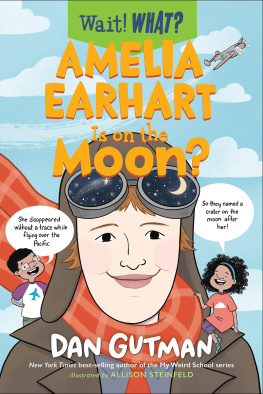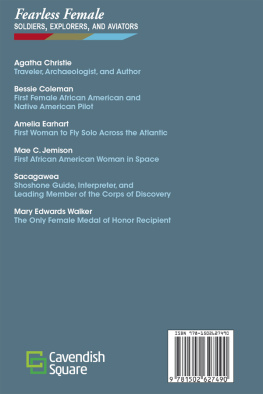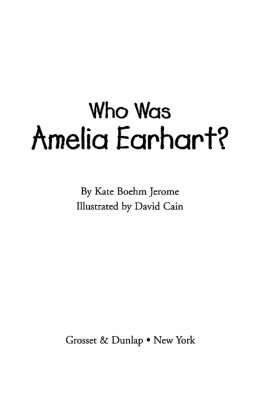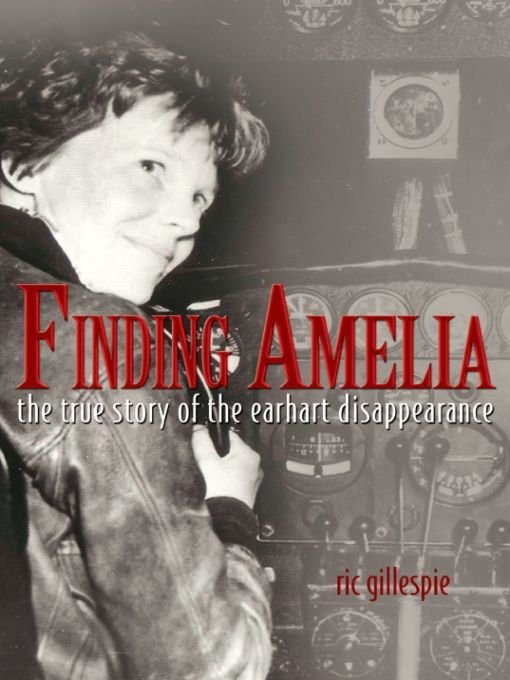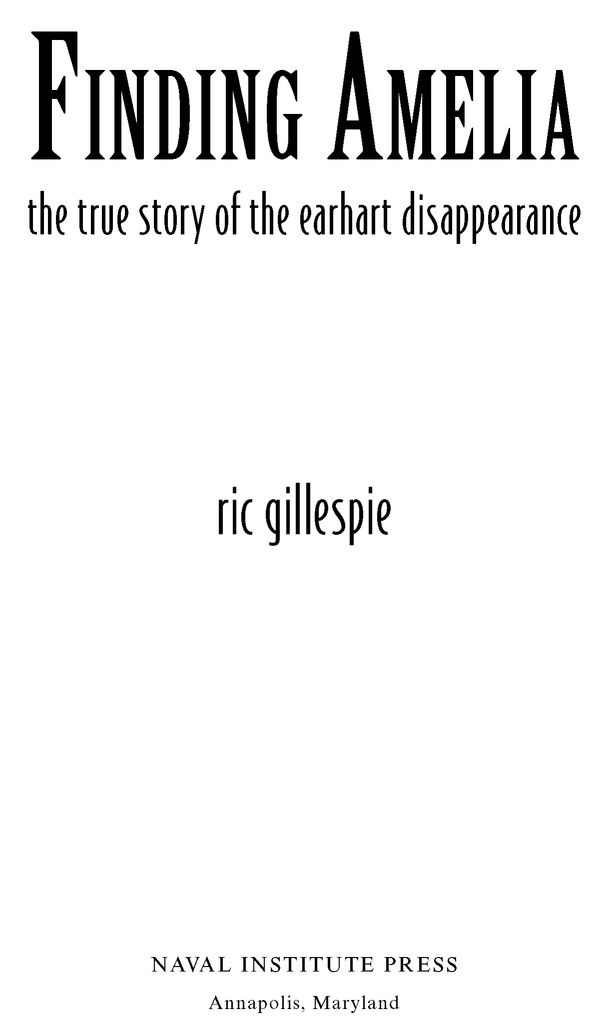Table of Contents
FOREWORD
It is difficult to write about a legend. Write too richly, and you merely add to the fable; write too cynically, and you will be a mere debunker. It is even more difficult when the legend vanishes into oblivion. Yet, in these pages on the disappearance of Amelia Earhart, one of Americas most famous aviators, Richard Gillespie has not only avoided these treacherous shoals but has also produced a narrative of epic scale, for he deals with the greatest elements of tragedy: human error and its awesome consequences.
Of Earhart herself, Gillespie writes with admirable professional detachment. Earharts piloting skills, he tells us, were average at best, but good looks, genuine courage, a talent for writing, and [her husband] George Putnams genius for promotion and media manipulation... made her one of Americas most famous and admired women.
Yet Earhart is not really Gillespies focus. Rather, it is the harrowing account, as far as anyone can trace it, of her last flight into the vast oblivion of the Pacific. In writing it, Gillespie has had to deal with three main challenges. First, that there is no incontrovertible physical evidence as to her fate, and what slender artifacts exist can at best provide the stuff of intelligent conjecture. Second, the most abundant evidence surrounding her disappearance is electronicthe records of radio telephone and telegraphand those records have been so voluminous, at times so contradictory, and on occasion so self-serving by those who sent them, that the totality of their meaning and import have been not been clear until now. Third, much heat but little light has been generated by the unfounded assertions, the irrational theories, and the melodramatic perspectives of several generations of amateur Earhart sleuth/enthusiasts who have had extreme opinions but little fact to buttress them. Like curiosity seekers at a crime scene, they have merely raised the level of confusion.
Gillespie has brought to his task an array of formidable qualifications to research and write what will probably be the most detailed and factual account of Amelia Earharts disappearance and the massive and failed attempt to find her that we shall ever have. An experienced general aviation pilot himself, a longtime risk-management specialist and aviation accident investigator, and a rigorous and determined researcher, he has tracked down numerous leads in government, business, industry, and aviation circles and has led a number of well-conceived and -organized search expeditions to the Equator and the possible terminus of Earharts flight.
Over the decades, the authors search has involved him in investigations across a small range of artifactsbuttons, shoes, pieces of aluminum; in a painstaking study of radio logs and photographic and cartographic data; and in a growing familiarity with such esoterica as tidal research and geomorphology. Where the trail has led to a dead end he has had the courage and good sense to drop it and seek answers elsewhere. But of all Gillespies tasks, none has been more important and more challenging than the collection, sorting out, and reintegration of the mass of radio communications surrounding the flight and the rescue effort into a comprehensible narrative, an effort that has combined careful and comparative analysis with the sensitivities of a skilled storyteller to weave a compelling narrative.
And what a narrative it is. Like viewers at a rerun of the old newsreel of the presidential motorcade entering Dallas on the morning of November 22, 1963, we read with growing dread of the Earhart departure from Lae, New Guinea, for her destination of Howland Island, a flyspeck on the map of the Pacific, knowing that she and her navigator, Fred Noonan, will never arrive. Thanks to Gillespie we also know how multiple were the miscalculations (a number by Earhart herself), the misapprehensions, the faulty equipment, and the faulty information that set her Lockheed Electra on its fatal trajectory and crippled all attempts to guide the pilot to a safe landing.
One reflects, too, on the fact that Earhart was six decades too early for access to a vital electronic systemglobal positioningthat could have identified for her and those seeking her where she was in the vastness of the ocean. Throughout the story, the hiss and crackle of empty airwaves that mark the futile efforts of Earhart and her would-be rescuers to communicate their locations to each other are a threnody of encroaching disaster. From this account it is also obvious, though not clearly stated, that the end of the crew of the Electra must have been quite terribledeath by drowning in the wreckage of a sinking aircraft or slow dehydration and death on the burning shores of a remote and uninhabited atoll hundreds of miles off their original course.
On other stages and at other times, Ric Gillespie has proposed a detailed and persuasive, if not conclusive, explanation of what happened to Amelia Earhart and Fred Noonan. I myself do not pretend to have strong views about her fate, nor would I argue that Gillespie has presented the final solution to the mystery of her disappearance. Indeed, in these pages, the author himself has not made this claim. He has, instead, attempted the most complete and fact-based history of the Earhart puzzle yet written. Brilliantly, he only hints at an explanation for the Earhart enigma here on the books last page, a suggestion left hauntingly in the air for us to ponder.
As a historian, I think I know good history when I read it. By its display of technological expertise, by its careful weighing of complex evidence, by its objectivity, and by its humanity, this is certainly first-rate history.
Mark Peattie
Asia-Pacific Research Center
Stanford University
June 4, 2006
ACKNOWLEDGMENTS
The research that made this book possible has been an eighteen-year voyage of discovery. The International Group for Historic Aircraft Recovery has been the vessel and I, as TIGHARs executive director, have been privileged to be the captain; but, like any skipper, I am only as good as the crew who work the ship. The facts presented in these pages testify to the dedication, intelligence, and generosity of the members of TIGHAR, without whom the boat would never have left the dock, let alone reached this point in our journey. Any errors in interpreting the facts are mine alone.
I am especially indebted to Dr. Randy Jacobson, without whose dogged pursuit of forgotten contemporary sources the true story of the Earhart disappearance could not have been told. Randy ferreted out the thousands of logs, letters, and official radio messages that detail the governments involvement in the tragedy; but finding the documents was only the first step. He then translated the archaic radio shorthand into Standard English and assembled the messages chronologically, converting innumerable, and often obsolete, time zones to Greenwich Time. Finally, he entered the assembled mountain of data into a computerized database. The enormous, yet easily searchable, files included on the DVD that accompanies this book are the product of his years of tedious, meticulous work.
Another special salute goes to Lt. Cdr. Robert L. Brandenburg, USN (Ret.). Bobs patient tutelage in the ways of the navy was of great help to a former army officer. More significant, his second career as a navy civilian scientist made it possible to quantify the credibility of the Earhart radio distress calls. Two of his research papers are included on the DVD.


